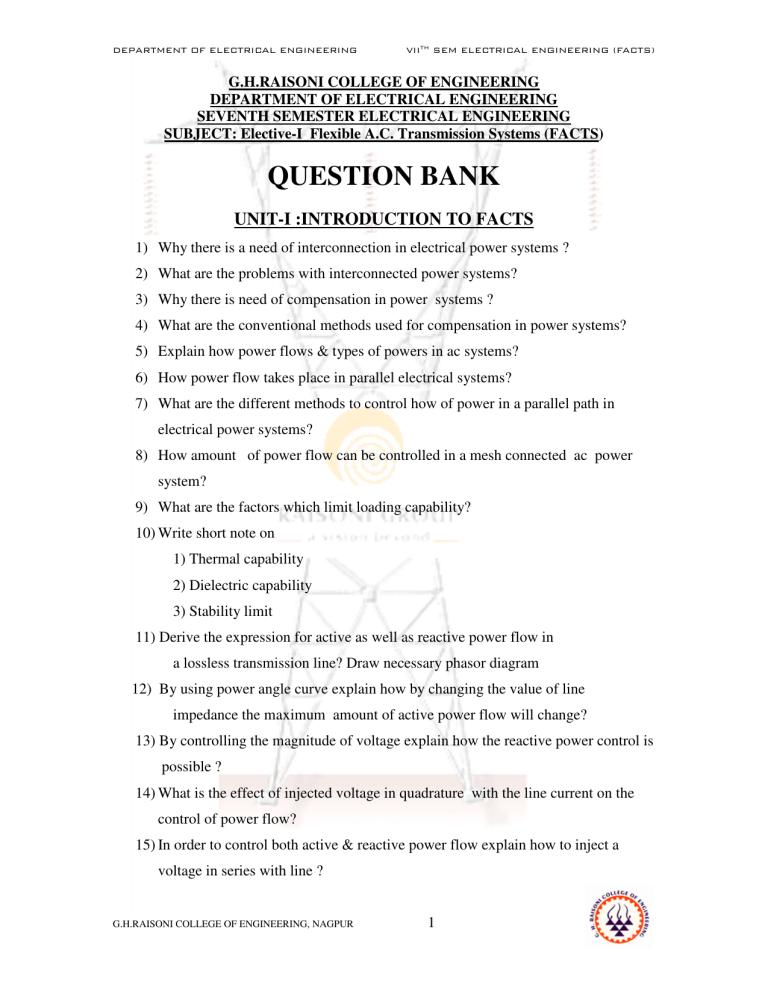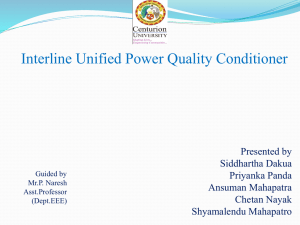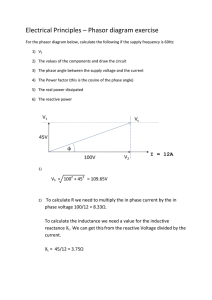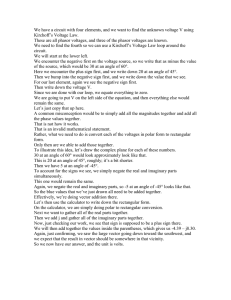question bank - GH Raisoni College Of Engineering Nagpur

DEPARTMENT OF ELECTRICAL ENGINEERING VII TH SEM ELECTRICAL ENGINEERING (FACTS)
G.H.RAISONI COLLEGE OF ENGINEERING
DEPARTMENT OF ELECTRICAL ENGINEERING
SEVENTH SEMESTER ELECTRICAL ENGINEERING
SUBJECT: Elective-I Flexible A.C. Transmission Systems (FACTS)
QUESTION BANK
UNIT-I :INTRODUCTION TO FACTS
1) Why there is a need of interconnection in electrical power systems ?
2) What are the problems with interconnected power systems?
3) Why there is need of compensation in power systems ?
4) What are the conventional methods used for compensation in power systems?
5) Explain how power flows & types of powers in ac systems?
6) How power flow takes place in parallel electrical systems?
7) What are the different methods to control how of power in a parallel path in electrical power systems?
8) How amount of power flow can be controlled in a mesh connected ac power system?
9) What are the factors which limit loading capability?
10) Write short note on
1) Thermal capability
2) Dielectric capability
3) Stability limit
11) Derive the expression for active as well as reactive power flow in
a lossless transmission line? Draw necessary phasor diagram
12) By using power angle curve explain how by changing the value of line
impedance the maximum amount of active power flow will change?
13) By controlling the magnitude of voltage explain how the reactive power control is
possible ?
14) What is the effect of injected voltage in quadrature with the line current on the control of power flow?
15) In order to control both active & reactive power flow explain how to inject a voltage in series with line ?
G.H.RAISONI COLLEGE OF ENGINEERING, NAGPUR 1
DEPARTMENT OF ELECTRICAL ENGINEERING VII TH SEM ELECTRICAL ENGINEERING (FACTS)
16) By drawing phasor diagrams explain different methods for controlling power flow
17) What are the different parameters to control power flow in ac systems given their relative importance ?
18) In case of series compensation what are the problems?
19) What are the basic types of facts controllers explain in short.
20) What is the importance of storage in case of converter based FACTS devices?
21) What are the different types of storage?
22) Definitions:
1) Fiexibility of Electrical power transmission .
2) FACTS
3) FACTS controllers.
4) STATCOM
5) SVS
6) TCR
7) TSR
8) TSC
9) SSC
10) TCSC
11) UPFC
23) what are the possible benefits of FACT’S technology.
24) Compare FACTS and HVDC.
G.H.RAISONI COLLEGE OF ENGINEERING, NAGPUR 2
DEPARTMENT OF ELECTRICAL ENGINEERING VII TH SEM ELECTRICAL ENGINEERING (FACTS)
UNIT II:VOLTAGE SOURCED AND CURRENT SOURCED
CONVERTERS
1) What are the types of converters basically used in FACTS devices & what are the differences between them?
2) Explain the working of single phase full wave bridge VSC?
3) Explain the construction & working of 3 phase full wave bridge type VSC?
4) Which types of harmonics are present in the o/p of 3 phase bridge converter?
5) Explain how different converter topologies work ? OR Explain how VSC will act as an inverter or a rectifier in inductive or capacitive mode?
6) What are the advantages of 12 pulse operation how it is achieve by transformer connections?
7) Why there is a need of 3 - level VSC Explain its working ?
8) What is PWM converter &what are its advantages.
9) Give Comparison of Voltage Sourced and Current Sourced converters
10) Explain the generalized technique for harmonic elimination.
11) Explain in brief Current Sourced Converters.
12) Which type of converters are generally used in FACTS devices.
13) Explain with the help of circuit diagram and waveforms single-phase leg operation of a VSC.
14) Explain how a VSC can be operated as a rectifier or inverter by controlling the valve conduction sequence.
G.H.RAISONI COLLEGE OF ENGINEERING, NAGPUR 3
DEPARTMENT OF ELECTRICAL ENGINEERING VII TH SEM ELECTRICAL ENGINEERING (FACTS)
UNIT III: SHUNT COMPENSATION
1) What are the objectives of shunt compensation ?
2) How shunt compensation is classified ?Explain in detail.
3) Explain TSC,TSC-TCR,FC-TCR,TSR & TCR by covering the following points.
(I) Diagram .
(II) Operation .
(III) V-I Char.
(IV) Loss char.
4) Why transient free switching of TSC is needed ? How it is achieved.
5) Explain the functional control scheme for
1) TSC
2) TSC – TCR
3) FC – TCR
6) Why VSC is preferred over CSC?
7) The operation of STATCOM is based on the operation of syn. m/c as rotating syn.
Condenser explain ?
8) Explain the working principle & V – I char. Of STATCOM ?
9) Draw control schemer of STATCOM & explain ?
10) What are the different types of losses in STATCOM ?
11) Why there is need of hybrid VAR generators?
12) What are the different types of hybrid VAR generators ?
13) Compare STATCOM with SVS?
G.H.RAISONI COLLEGE OF ENGINEERING, NAGPUR 4
DEPARTMENT OF ELECTRICAL ENGINEERING VII TH SEM ELECTRICAL ENGINEERING (FACTS)
UNIT IV: SERIES COMPENSATION
1) State objective of series compensation.
2) Explain how GCSC & TCR are duals of each other.
3) Explain how series compensation can be used for power oscillation damping.
4) Explain with a neat sketch and waveforms the GCSC type of series controller.
5) Draw the compensating voltage v/s line current characteristics of TCSC & SSSC.
6) Explain with a neat sketch and waveforms the TCSC type of series controller.
7) Explain with a neat sketch and waveforms the SSSC type of series controller.
8) Give the functional control scheme for a SSSC.
9) Explain what do you mean by Variable Impedance type and Switching Converter
type FACTS devices.
10) How voltage stability at load bus can be achieved using series compensation.
11) How series FACTS devices respond to the problem of Subsynchronous resonance.
12) With the help of power angle curve explain how transient stability is improved with the help of series controllers.
13) Draw V-I Characteristics and loss characteristics for: i) GCSC ii) TCSC iii) SSSC
G.H.RAISONI COLLEGE OF ENGINEERING, NAGPUR 5
DEPARTMENT OF ELECTRICAL ENGINEERING VII TH SEM ELECTRICAL ENGINEERING (FACTS)
UNIT V: VOLTAGE AND PHASE ANGLE REGULATORS
1) State the objectives of voltage and phase angle regulators.
2) What is the need of using power electronics based regulators.
3) Explain the basic concept of voltage regulator with the help of a phasor diagram.
4) Explain the basic concept of phase angle regulator with the help of a phasor diagram.
5) For a two- machine power system , explain how power flow can be controlled using phase angle regulators. Give the P-delta curves.
6) Explain how real and reactive power flow control is achieved using phase angle regulators.
7) Justify the improvement in transient stability with phase angle regulators by giving the power angle curve .
8) Explain how power oscillation damping can be achieved by using voltage and phase angle regulators.
9) Explain the concept of thyristorised voltage and phase angle regulators.
10) Give circuit diagram ,wave forms and detailed analysis of a continuously controllable thyristor tap changer.
11) Explain the operation of a continuously controllable tap changer on purely inductive and capacitive loads.
12) What are the drawbacks of continuously controllable tap changer.
13) Give circuit diagram , and detailed analysis of a discrete level thyristor tap changer.
14) Explain concept of switching converter based voltage and phase angle regulators.
15) What do you mean by hybrid phase angle regulators. Give block diagram for one such scheme.
G.H.RAISONI COLLEGE OF ENGINEERING, NAGPUR 6
DEPARTMENT OF ELECTRICAL ENGINEERING VII TH SEM ELECTRICAL ENGINEERING (FACTS)
UNITVI:SPECIAL CONTROLLERS
1) Explain the basic operating principle of an UPFC.
2) Explain how a UPFC is different than a simple VSC.
3) How an UPFC scheme can be implemented using two back to back voltage source converters.
4) Give the block diagram for a basic UPFC control scheme.
5) Differentiate clearly between an UPFC & IPFC
6) Give a basic two-converter scheme for IPFC.
7) Explain how the control of a basic IPFC is achieved
8) What do you mean by a generalized FACTS controller.
9) Give the block diagram for a generalize IPFC.
10) By means of an block diagram simulate a generalize IPFC which can be operated as a STATCOM , SSSC , UPFC OR IPFC.
11) Explain in detail the phenomenon of sub synchronous resonance (SSR) with an example.
12) Explain why present transmission system with capacitive series compensation is prone to SSR.
13) Give the objective of NGH-SSR damping scheme
14) Give detailed explanation NGH-SSR damping scheme with circuit diagram, wave diagram & control scheme.
15) Explain the basic control of TCBR.
16) How TCBR. is used to improve the transient stability.
17) Give use of TCBR for power oscillation damping.
G.H.RAISONI COLLEGE OF ENGINEERING, NAGPUR 7



